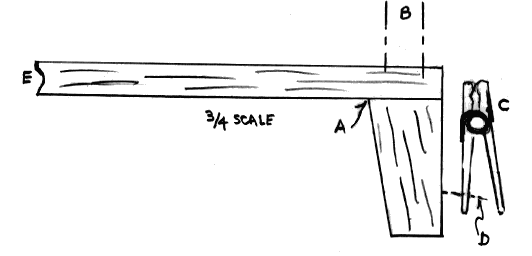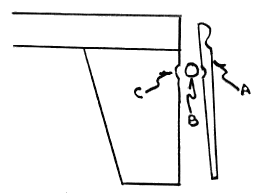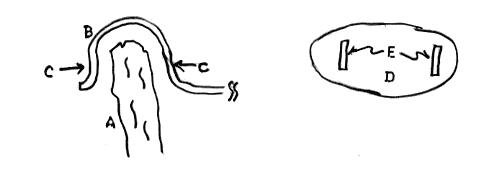THE RUBBER GUN
Rubber gun technology is based on the availability of suitable
elastic bands. We traditionally used strips and bands cut from the inner
tubes of automotive tires. Since the advent of tubeless tires, this
material is increasingly hard to find. But "inner tubing" on
snow is still popular, and the tubes must come from somewhere.
Industrial and truck tires still use tubes — discarded ones might be found
at service stations that engage in this kind of work. Ruined tubes, no
longer fit for service, do just fine for our application and might be free for
the asking. Live rubber is extinct, having been replaced by butyl
(synthetic) rubber in the 40's. Butyl is good and is much more
durable than the product from rubber trees. Motorcycle shops are a good
place to look for old tubes. Dirt bikes are particularly hell on tires
and tubes. Rubber bands, cut from motorcycle inner tubes, can be made
longer by loop-knotting two or more together. The ultimate material is
surgical tubing but this must be purchased and is expensive. We are
interested in things that can be made without cost by a kid. Don't be
suckered by vinyl tubes, air mattresses, and wading pools because most
plastics lack elasticity.

The basic pistol is made from a scrap of 1" board (usually
7/8" thick). Referring to the high-class mechanical drawing, it can
be sawed or whittled as one piece. But the barrel and grip should
be separate pieces (A) so that the grain runs in a direction to reduce
breakage, as shown. The grip is slender so that, with the
clothes pin mounted, it can be grasped by an immature hand. Only the
front of the grip is tapered to give a little rake. Two nails (B) fix
the parts together and keep them from twisting crooked. A
small-diameter wood screw, replacing one of the nails, will keep them
from prying apart. Daddy saw me split a handle, driving a screw,
and taught me about "pilot" holes (tap hole) for both nails and
screws. A pilot hole also makes a screw much easier to drive. He
gave me access to a small hand drill and his drill bit selection.
The top piece of the clothes pin (C) is removed so that a wire
brad can be driven (D) to position the clamp (clothes pin) with the nose
slightly below the top edge of the barrel. A shallow notch (E) is carved
into the muzzle of the barrel to retain a loaded rubber band. To
load the gun, a rubber band is clamped first and then stretched over the end
of the barrel. It is discharged by squeezing the grip assembly.
With only the coil spring to grip a band, very little stretching tension can
be used. A universally used method, of holding the projectile
band tighter, is to twist a band tightly around the top of the clamp and the
upper part of the grip. Thus, the projectile can be stretched tighter,
giving more velocity, range, and stinging power. A simple knot in the
middle of a projectile effectively shortens it to make it stretch tighter.
The knot also increases the range by cutting air resistance. Projectiles
can be effectively shortened by folding over a portion that goes in the clamp.
A SECRET WEAPON
 I invented this method of doubling the firepower of a rubber
gun (two shots instead of just one). (A) is the bottom half of a clothes
pin and (B) is a #10 bolt. (C) are shallow depressions, in both the
handle and clothes pin, to position the bolt. A band is stretched
tightly around the top of this first clamp and the upper part of the
handle — this has to be tighter than the final band applied to the complete
assembly. After the top half of the clothes pin is assembled, the first
clamp is loaded first, followed by a normal loading of the second. A
normal squeeze lets the first shot go, and a more firm squeeze releases the
second one.
I invented this method of doubling the firepower of a rubber
gun (two shots instead of just one). (A) is the bottom half of a clothes
pin and (B) is a #10 bolt. (C) are shallow depressions, in both the
handle and clothes pin, to position the bolt. A band is stretched
tightly around the top of this first clamp and the upper part of the
handle — this has to be tighter than the final band applied to the complete
assembly. After the top half of the clothes pin is assembled, the first
clamp is loaded first, followed by a normal loading of the second. A
normal squeeze lets the first shot go, and a more firm squeeze releases the
second one.
My adversary thought I had shot all my rubbers and arrogantly
swaggered toward me to finish me off. I blew him away with my
secret weapon and still had one loaded on my other gun. Everyone soon
learned not to depend on counting shots. They would cautiously see if
there was a rubber stretched over the muzzle of my gun. The other
boys eventually started using this device. I always stretched a
dummy band, end to end on the barrel, so that the gun appeared to be
loaded even after I had fired it twice. It is fun to keep the enemy at
bay by brandishing an empty gun.
THE RIFLE / MACHINE GUN
Our answer to the BAR (Browning automatic rifle). With a
little practice you can tick off single shots, a bust of two or three, or
spray-and-pray all of them at once, as seen in bad TV plots.

The rifle is a common 1" board with notches (A) made
with two saw cuts and the divot broken out. Notches have to be farther
apart than the length of the notch or the wrong piece will break out.
The rip cord (B) is fastened in front of the front notch with a big thumb tack
or small nail (C). A flat boot lace makes a perfect cord,
although any kind of cord or twine can be used. It should be carefully
centered under each loaded rubber to prevent misfires. The muzzle (D) is
wide and deep enough to accommodate all the rubber that will be stretched over
it. Projectiles must be a looped at both ends (unlike for pistol where
one end can be open). Works most effectively if projectile lengths are
customized to fit notch position, longer for the rear notches. Rubbers
can be knotted for ballistic efficiency, but a full loading bulges somewhat.
In use, the front notch is loaded first, etc. This is not
a shoulder weapon — the butt of the piece is tucked in the arm pit to brace
it against the vicious recoil.
SPECIFICATIONS
A rubber gun can reliably hit an enemy Munchkin at 10-15 foot.
Maximum range is 25-30 foot or more, depending on how tightly the projectile
is loaded and its air resistance. Group size is 6" at short
distance and perhaps 12" or more at longest range. Because of their
design, rubber guns throw projectiles in an arc above the barrel line.
The shootist becomes quite good at instinct shooting and deliberate
point-shooting, without the use of sights. The device is deadly on house
flies, but Mama will soon get sick of the unsightly smears on walls,
ceilings, and kitchen fixtures.
The official uniform is bib overalls with (weather permitting)
no underwear, no shirt, and barefoot. Visualize Arnold Swarzeneger,
Sylvester Stallone, and Bruce Willis in guerrilla jungle-warfare regalia,
shrunk to three foot tall — that's the way we envisioned ourselves.
Equipment (as available) :
1. plastic helmet.
2. genuine U.S. issue, helmet liner (always too large).
3. leather aviators helmet complete with ear flaps and
goggles.
4. small wooden shield.
5. rifle, bulging with knotted rubbers, slung over
shoulder.
6. brace of pistols, loaded, stuck in overall openings
at waist.
7. emergency hide-out pistol in rear pocket.
8. bundles of inner-tube rubbers, hanging wherever
(appearance of a gillie suit).
RULES OF WAR
(established by the Grenola Convention)
A hit anywhere on the person or clothing of a Jap, Nazi,
or Wop constitutes a "kill". This depends a lot on the honor
system. There are no pussy-wimp sanctions for prisoners . . .
in fact, there is no such thing as a prisoner. The enemy's rubbers can
be reused but you can't loot a dead guy's equipment or ammo — he will need
them when he comes back to life for a new combat. Forts can be
constructed as a stationary shield and home base. Mobile shields made
of chicken wire are disallowed because of their effectiveness. A sacred
object, in the possession of one team, can be designated as the goal of
conquest. Girls passing through the war zone may be blasted mercilessly
by both sides. Adults may NOT be shot and sometimes serve as a
living shield for a raider. A truce is called or a tie declared if
everyone has to go home for supper.
SLING SHOT
The sling shot is an effective missile weapon on small animals
and birds out to 25 yards. It is accurate and becomes better with
practice.
The basic -Y shape can be cut from a suitably shaped bush or
tree branch. The more symmetrical, the better. The tines (A)
are about 3/4" diameter, strong enough to withstand heavy pull. The
handle is ideally larger, maybe 1" diameter, to provide a firm grip.
The elastic strap (B) is a strip of inner-tube rubber 10-12" long.
Surgical rubber tubing is the best strap material but expensive. The
wider the strap, the harder to pull and the more power generated.
One end is bound to a tine by wrapping (C) with
strong string. The orientation is fore/aft — the strap faces
away from the user and is pulled back between the tines to draw and
shoot. This is most accurate and puts less stress on the binding.
Before tying the strap to the opposite time, thread it through the
slots (E) of the cup (D). Needless to say, the strap is on the back
side, toward the user. The cup is flexible leather or two to three
layers of heavy canvas. The slots should be cut cleanly (razor blade) so
they won't tear out.
You can cast pebbles or peanuts for plinking or hunting, but
the best accuracy is with glass marbles because of their perfect shape.
Unfortunately, kids can't afford to throw marbles away. Nor can they
afford ballistically-ideal bullets ; 36 or 45 caliber, lead, musket
balls.
(10-02 Bill F.)
Return


 I invented this method of doubling the firepower of a rubber
gun (two shots instead of just one). (A) is the bottom half of a clothes
pin and (B) is a #10 bolt. (C) are shallow depressions, in both the
handle and clothes pin, to position the bolt. A band is stretched
tightly around the top of this first clamp and the upper part of the
handle — this has to be tighter than the final band applied to the complete
assembly. After the top half of the clothes pin is assembled, the first
clamp is loaded first, followed by a normal loading of the second. A
normal squeeze lets the first shot go, and a more firm squeeze releases the
second one.
I invented this method of doubling the firepower of a rubber
gun (two shots instead of just one). (A) is the bottom half of a clothes
pin and (B) is a #10 bolt. (C) are shallow depressions, in both the
handle and clothes pin, to position the bolt. A band is stretched
tightly around the top of this first clamp and the upper part of the
handle — this has to be tighter than the final band applied to the complete
assembly. After the top half of the clothes pin is assembled, the first
clamp is loaded first, followed by a normal loading of the second. A
normal squeeze lets the first shot go, and a more firm squeeze releases the
second one.

